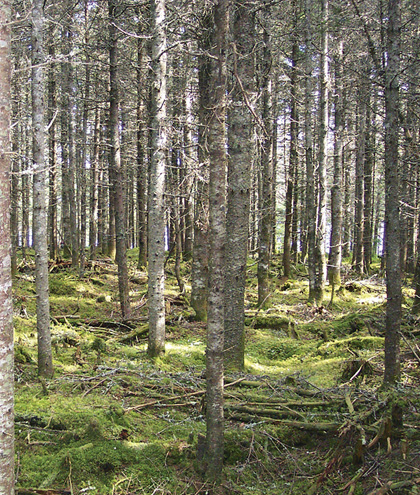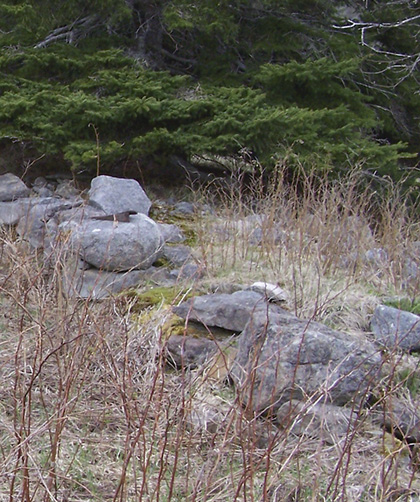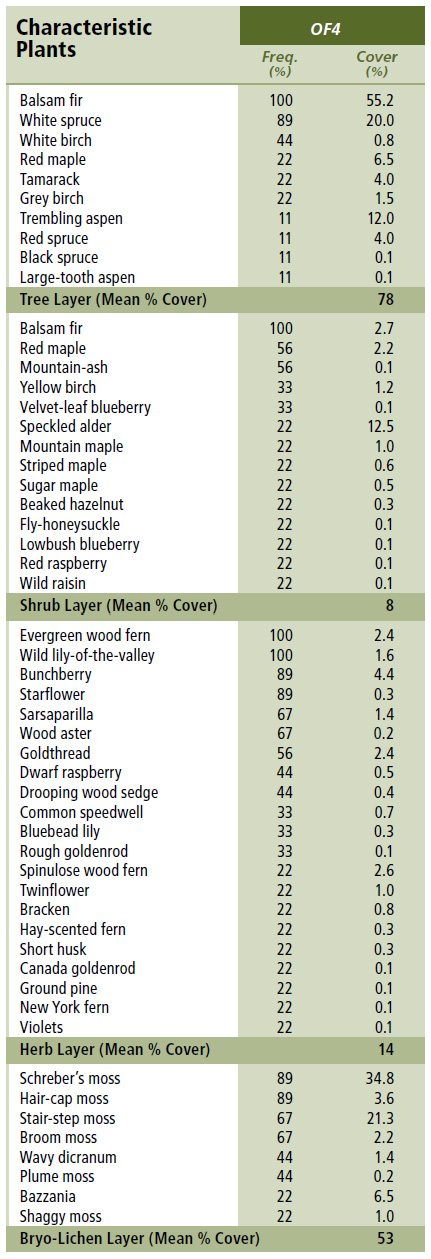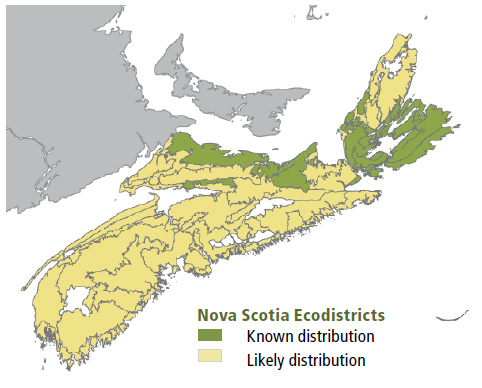
Forest Vegetation types - OF4
OF4 — Balsam fir – White spruce / Evergreen wood fern – Wood aster
Abies balsamea – Picea glauca / Dryopteris intermedia – Aster acuminatus
 |
Rory Neils Lake, Richmond County |
Concept: This early to mid-successional Vegetation Type (VT) has an overstory dominated by balsam fir, usually with a strong component of white spruce. This VT is a second-generation old field forest which develops from previously harvested or severely disturbed OF1, OF2, OF3 or OF5 stands. Understory flora associated with this VT are more abundant and representative of natural forest conditions than those of other old field forest types. OF4 is found throughout the province, but is mainly associated with previous OF1 (White spruce / Aster – Goldenrod / Shaggy moss) stands.
Vegetation: Balsam fir and white spruce are the dominant overstory trees, while red maple, tamarack and white birch are common associates. The shrub layer is dominated by regenerating trees, especially balsam fir, with lesser red maple, yellow birch and sugar maple. The presence of striped maple and mountain maple indicates a return to more natural vegetation conditions. In the herb layer, fewer of the species indicative of past agricultural land use are found. Instead, evergreen wood fern, wood aster, sarsaparilla and other flora typical of upland forest are more common. Moss cover is variable, with Schreber's moss, stair-step moss and hair-cap moss the main moss species found.
Environmental Setting: OF4 is mainly associated with fresh to fresh-moist, nutrient medium to rich soils of variable texture. This VT is found throughout Nova Scotia, but is primarily associated with several Nova Scotia Upland ecodistricts (Cobequid Hills, Cobequid Slopes, Cape Breton Hills, Pictou Antigonish Highlands) and the Atlantic Coastal and Fundy Shore ecoregions. Sites that were tilled or pastured generally have level microtopography and a visible Ap (plough layer) soil horizon.
Successional Dynamics: OF4 is an even-aged, early to mid-successional VT dominated by balsam fir. This VT originates from advanced regeneration established under first generation old field forests (usually old field white spruce). Natural disturbance agents include insects (bark beetles, tussock moth, spruce budworm) and windthrow. Later successional stages will generally include species from the original forest cover, especially if seed sources are nearby. Possible late successional stages include TH1 (Sugar maple / Hay-scented fern), TH2 (Sugar maple / New York fern – Northern beech fern), MW1 (Red spruce – Yellow birch / Evergreen wood fern) and MW3 (Hemlock – Yellow birch / Evergreen wood fern). Stands that slowly deteriorate are more likely to succeed to such forest conditions as shade-tolerant species regenerate on site. Clearcut harvesting may initiate an earlier successional stage dominated by grey birch, pin cherry, aspen, white birch and other woody shrubs.
Ecological Features: This second-growth patch forest follows stand-level disturbances of old field forests (OF1, OF2 and OF3). These disturbances may accelerate succession towards pre-agricultural forest conditions. Past cultivation has leveled most pre-disturbance microtopography, while rock walls and piles, old foundations and wells provide additional evidence of past agricultural land use. Linear rock piles may provide dwellings for rodents, snakes, and insects like wasps and bees. These forests are often close to open fields and farms, and depending on their disturbance history, may contain large white spruce snags and fallen stems. OF4 may attract deer, red fox, coyote, snowshoe hare, red squirrels and pileated woodpeckers. It provides excellent growing conditions for mycorrhizal mushrooms including chanterelle and
various boletes.
 |
| Rock wall (John Gillis) |
Distinguishing Features: This softwood forest is dominated by balsam fir that usually originates following harvesting of a previous old field forest. Shrubs and herbs tend to be more indicative of natural forest conditions.
| Slope Position: | Level4 Middle4 Upper2 |
Surface Stoniness: |
(Non - Slightly)10 |
Bedrock Outcrop: |
(Non-rocky)10 |
Elevation Range: |
11 - 316m |
Slope Gradient: |
Gentle6 Level4 |
Aspect: |
North4 West2 None4 |
Exposure: |
Moderate6 Exposure3 Mod. exposed1 |
Microtopography: |
Slightly6 Level2 Moderately1 Strongly1 |
Drainage: |
Well6 Imperfect3 Moderately well1 |
Soil Type: |
ST2-L6 ST93 ST81 |
Parent Material: |
Glacial till10 |
Rooting Depth (cm): |
(<30)1 (30-45)6 (>45)3 |
Duff Thickness (cm): |
(0-5)4 (6-10)1 (11-20)5 |

